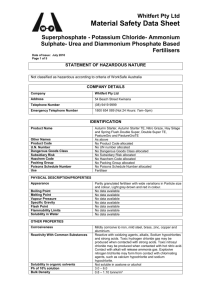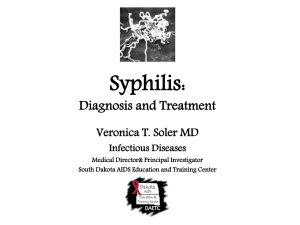summit quinphos fert presentation
advertisement
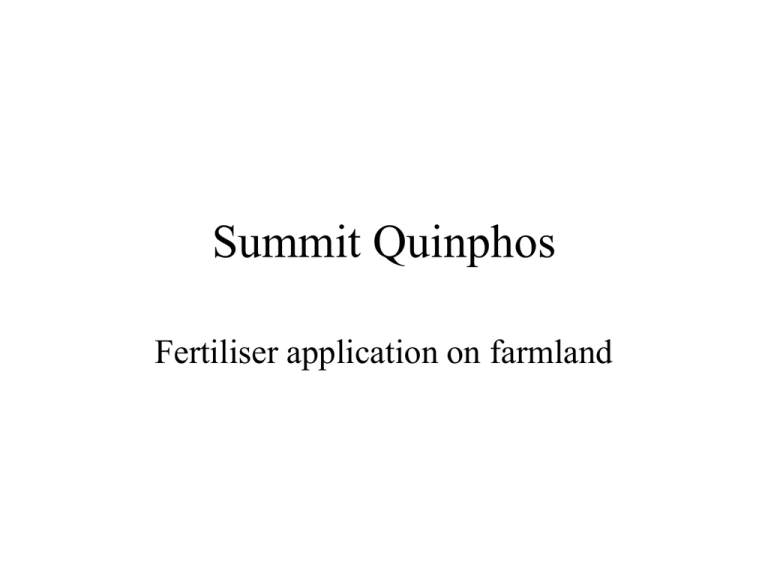
Summit Quinphos Fertiliser application on farmland Why do farmers apply fertiliser? • All living organisms require some basic chemical elements to function i.e. to build DNA , cells walls etc • The major elements required are; – nitrogen, phosphorus, potassium, sulphur, calcium and magnesium • If any one of these elements is deficient – grass will not grow – or will not grow as well as it could Why do farmers use fertiliser? • To over come nutrient deficiencies • To replace nutrients transferred: – off farm in production i.e. milk, meat, wool,crops – to unproductive areas of the farm i.e. effluent ponds, tracks What are the environmental problems associated with fertiliser application? • Phosphate runoff – Approximately 80% of the phosphate in our waterways comes from agricultural runoff • Nitrate leaching – A study in the late 80’s indicated that up to 20% of ground wells in Taranaki and Waikato had over 10mg/l nitrate – The recommended maximum level is 11.3mg/1 These affect water quality • By causing algal blooms and excessive weed growth which – stops us drinking it – stops recreational activity – stops us eating the fish – and kills aquatic life How do excess nutrients get into waterways? • Direct application – animals depositing directly in waterways – fertiliser spreaders applying too close to waterways • Erosion – pugging & compaction • Runoff – surface runoff – sub-surface runoff • Leaching What does Summit Quinphos do to minimise the environmental effects • Design a fertiliser plan for each farms specific needs. – This includes: • • • • Nutrient budgeting GPS Soil & Herbage testing Farm Environment Maps Summit Quinphos environmentally protective fertiliser What is Nutrient Budgeting? • It is a balance of nutrients onto and off the farm • Works in a similar manner to a financial budget • A fertiliser recommendation is using a simple form of nutrient budgeting How do we do it? • Use fertiliser recommendation models • Or more advanced nutrient budgeting computer models e.g. Overseer The information Overseer uses includes: • • • • • • Inputs Stock & production information Climate data Topography Soil type & fertility Fertiliser GPS Soil & Herbage Testing • Soil & herbage tests done at least every 2 years • Soil tests show what nutrients levels are in the soil and show trends over time • Herbage tests are needed to fine tune a fertiliser programme in the short term – tests for trace elements – checks on how well the grass is taking up the major elements in the soil. GPS - Global Positioning Systems • Uses satellites to accurately locate where soil & herbage tests have been taken: – Which increases reliability and accuracy of soil & herbage testing so; – I can give farmers better advice. Summit Quinphos Environmentally Protective Fertiliser • RPR - Reactive Phosphate Rock • Sustain • Protect PAPR What is Reactive Phosphate Rock (RPR) • RPR’s are natural minerals formed on the ocean floor over thousands of years • Over time dead sea organisms form layers • In certain areas these layers become enriched with phosphate absorbed from sea water • And form a mineral which is part phosphate and part calcium carbonate (lime) How does RPR work? • RPR’s chemical structure is very unstable – Because of the carbonate in the rock; – Which means RPR can be dissolved by the weak organic acids in the soil. • Superphosphate comes from hard phosphate rocks. – These rocks are very insoluble. – To release the phosphate so plants can use it; – The hard rock needs to be treated with a very strong acid (sulphuric acid). PHOSPHATE SOURCES HARD PHOSPHATE ROCK REACTIVE PHOSPAHTE ROCK + minus SULPHURIC ACID CALCIUM = SUPERPHOSPHATE = PLANT AVAILABLE PHOSPHATE + PHOSPHORIC ACID + AMMONIA = TRIPLE SUPERPHOSPHATE DI - AMMONIUM PHOSPHATE 18 N 20 P 2 S 21 P 2 S = Key Factors Affecting RPR Availability • Two key factors affect the ability of RPR to be dissolved 1 How acidic the soil is 2 How easily calcium can move away from the RPR particle i.e. rainfall – These two factors mean that the breakdown of RPR is a gradual process (slow release) Phosphate Runoff • Approximately 80% of the phosphate in our waterways comes from agricultural runoff • Research in NZ & Ireland shows that a significant, and often the major proportion of this runoff comes directly from recently applied water soluble phosphate fertiliser – Superphosphate, Triple Superphosphate, DAP Reactive Phosphate Rock (RPR) • Research has proven that runoff from RPR is 25 times less than Superphosphate • This is because: – is not water soluble – has a greater density than water soluble phosphate Nitrate Leaching • Dairy cattle numbers have gone from 2.9 million to 4.1 million • N fertiliser use has gone from 117,000 tonnes of N in 92/93 to 333,000 tonnes in 01/02 • A cows urine patch contains the equivalent of 500-1000 kg N/ha Nitrate Leaching cont.. • At normal rates of application leaching losses from nitrogen fertilisers are typically 5-10% of nitrogen applied. Sustain • Sustain is urea that has been coated in Agrotain & Sulphur. – Sustain reduces leaching losses of nitrogen. – And also reduces ammonia volatilisation losses to the atmosphere Sustain • Agrotain slows the breakdown of the urea. – Urea breaks down over 0-2 days – Sustain breaks down over 0-10 days • Slowing the breakdown of urea gives the plant more opportunity to take up nitrogen therefore leaving less nitrogen available to be leached. Protect PAPR • PAPR - Partially Acidulated Phosphoric Rock • RPR is reacted with phosphoric acid – in a similar process to superphosphate • It combines both water soluble phosphate and slow release phosphate. • Has less runoff than superphosphate Farm Environment Maps • The Farm Environment Maps include: • information on soil type – this helps me decide where on a farm to soil test • information of the risk of phosphate loss from: – water soluble phosphate – RPR phosphate • The maps can help me decide what form of phosphate fertiliser to use on a particular farm • Will include information on the risk of nitrate leaching • And faecal bacteria runoff In Conclusion – – – – – The Farm Environment maps GPS soil & herbage testing Nutrient budgeting Summit Quinphos fertilisers And talking to the farmer All help me to produce a fertiliser plan that is specific to a particular farms requirements and at the same time minimise the environmental risks of applying fertiliser.


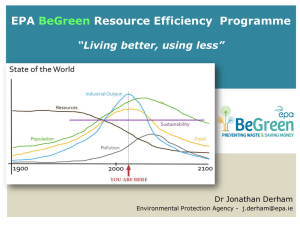
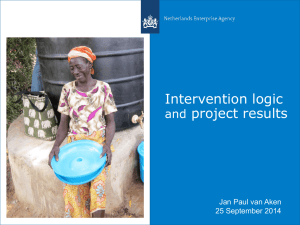


![Agricultural_Sustainability[1]](http://s2.studylib.net/store/data/005504133_1-9ffa4b75dedc8be02135b69bd90d288e-300x300.png)
